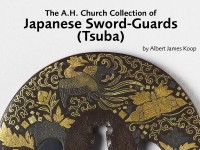The A. H. Church Collection of Japanese Sword-Guards (Tsuba)
An unpublished catalogue of the A. H. Church collection of Japanese sword-guards (tsuba) by Albert James Koop.

Publications online: 37 objects
Show search helpAori-shaped tsuba depicting charms, coins, and three of the Seven Treasures
-
Literature notes
Aori; on a ground etched with wood pattern (including the edge) are represented five coins and charms in low relief or in incrustation of shakudō and shibuichi; also, inlaid in gold-cloisonné enamel are three of the Seven Treasures (cash, clove, double axe-head).
Yasuchika style (Group XL), placed here because of the enamel. -
Details
- Associated place
- Date
- c. 1850
- Material and technique
- copper, with etched decoration, inlaid with shakudō and shibuichi, and gold wire cloisonné enamel; tang-hole plugged with soft metal, probably copper
- Dimensions
- 6.2 x 5.3 cm (height x width)
- Material index
-
processed material › metal › alloy › copper alloy › shakudō,processed material › metal › alloy › copper alloy › shibuichi,processed material › metal › alloy › silver alloy › shibuichi,processed material › metal › gold,
- Technique index
-
printed › intaglio print › etching,
- Object type index
-
arms/armour › koshirae › kodogu › tsuba
- No. of items
- 1
- Credit line
- Bequeathed by Sir Arthur H. Church, 1915.
- Accession no.
- EAX.11166
-
Further reading
Koop, Albert James, The A. H. Church Collection of Japanese Sword-Guards (Tsuba), 3 vols (Oxford, Ashmolean Museum, 1929), no. 1166
Glossary (4)
cloisonné, shakudō, shibuichi, tsuba
-
cloisonné
Decorative technique in which wires are attached to a metal body and coloured enamels are applied between the wires.
-
shakudō
alloy of copper and gold, patinated to a dark blue-black colour
-
shibuichi
alloy of copper and silver, patinated to a dull grey-green colour
-
tsuba
Japanese sword guard.
Location
-
- currently in research collection
Objects are sometimes moved to a different location. Our object location data is usually updated on a monthly basis. Contact the Jameel Study Centre if you are planning to visit the museum to see a particular object on display, or would like to arrange an appointment to see an object in our reserve collections.
Publications online
-

The A. H. Church Collection of Japanese Sword-Guards (Tsuba)
Aori; on a ground etched with wood pattern (including the edge) are represented five coins and charms in low relief or in incrustation of shakudō and shibuichi; also, inlaid in gold-cloisonné enamel are three of the Seven Treasures (cash, clove, double axe-head).
Yasuchika style (Group XL), placed here because of the enamel.
Notice
Object information may not accurately reflect the actual contents of the original publication, since our online objects contain current information held in our collections database. Click on 'buy this publication' to purchase printed versions of our online publications, where available, or contact the Jameel Study Centre to arrange access to books on our collections that are now out of print.
© 2013 University of Oxford - Ashmolean Museum

